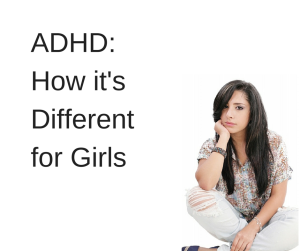An ADHD diagnosis is far more common in males than females. However, many girls are often undiagnosed in childhood and only later in life realize that they, too, fit the diagnostic criteria. This lack of timely diagnosis and treatment has the potential to create far-reaching consequences academically, psychologically and socially, particularly in teenage girls. Why aren’t girls diagnosed with the same frequency as boys? The answer is that ADHD has a tendency to look very different in girls.
ADHD in females is often far more subtle and doesn’t fit neatly into the common stereotypes because girls tend to be less hyperactive and more compliant than boys, making ADHD more difficult to spot. Girls are far more likely to drift along in elementary school and struggle less than boys academically while, at the same time, falling far short of their potential and flying under the radar for referrals. By the middle and high school years, teenage girls often experience more apparent academic and social problems due to the increased demands and pressure to succeed.
What does a teenage girl with ADHD look like? The answer is; it depends on the girl. Some girls with ADHD may, in fact, be hyperactive and drawn to activities that are typically thought of as boyish. They tend to be disorganized, messy, rushers and risk takers, and tend to be viewed as undisciplined and unmotivated academically. Others fit into the daydreamer category. They are often shy and overlooked. Also, although they may appear to being paying attention, their minds are often elsewhere. The diagnosis of ADHD/Inattentive is an easy one to miss. These girls are quiet and not really bothering anyone, although they may be struggling tremendously internally. They tend to be anxious, self-critical and often appear depressed. Another form of ADHD seen in girls is a combination of both the hyperactive and inattentive types of ADHD, although these girls are often more hyper-talkative than hyperactive. Girls with a combined type diagnosis may present as active, excitable and emotional, have difficulty staying quiet in the classroom, interrupt others frequently and jump from topic to topic due to difficulty with organization of their thoughts. They tend to be risk-takers and often fall short of their potential academically.
Interestingly, teenage boys with ADHD tend to externalize their symptoms. They blame others for their poor grades, blame the stupid test they didn’t do well on, they act out and they act up. Boys with AHDH are usually difficult to ignore and are far more likely than girls to get the academic services and accommodations they need to succeed. Teenage girls, however, tend to be internalizers. They are more likely to blame themselves and turn their anger, frustration and pain inward. Without proper diagnosis, an understanding of how their unique brains work and without support for their skill deficits, every failure becomes evidence of their inadequacy. Girls often harbor feelings that they don’t belong, believe they are not smart enough, and view themselves quite simply as not being good enough. The price teenage girls with ADHD pay is far too often that of poor self-esteem, chronic stress, depression, anxiety and a constant feeling of being overwhelmed. These feelings arise from the very nature of the disorder itself; disorganization, poor time management, chronic lateness, difficulty sustaining attention, weak emotional control, distractibility and generally poor executive skills.
What do teenage girls with ADHD need to thrive? Knowledge and support. Knowledge becomes power as the true nature of the ADHD diagnosis is revealed and its power to impact all life areas is uncovered. This self-knowledge sets the stage for change and self-advocacy. Support is essential to the successful management of ADHD. Skills need to be developed and turned into habits. Negative mindsets need to be reset. Structure must be created to develop routines. A sense of resiliency and mindfulness must form. And, compassion and understanding must prevail within the self and within the environment. ADHD is different for girls, but while it may be more subtle and not fit the common male stereotype of ADHD, it is no less debilitating and much more emotionally devastating in females.
By Marj Harrison, M.A., Ed.M. – © 2013 PTS Coaching. All rights reserved. Articles may be reproduced or electronically distributed as long as attribution to PTS Coaching is maintained.
“Image courtesy of Artur84/FreeDigitalPhot.net” Modified on Canva.com


